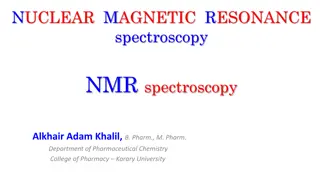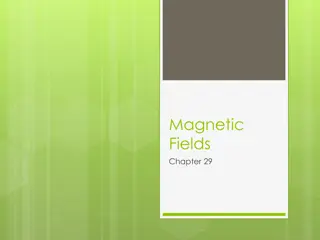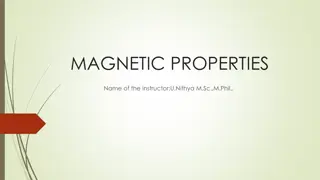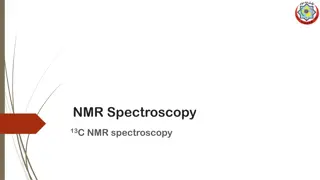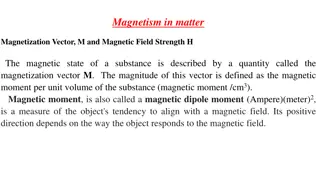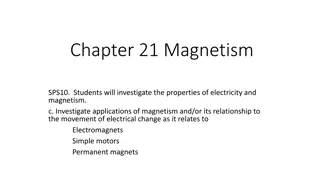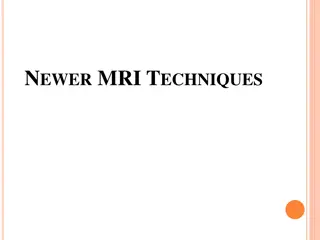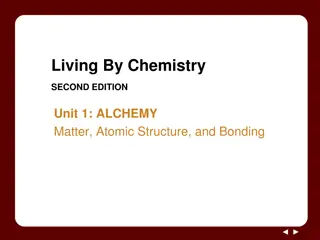Understanding Nuclear Magnetic Resonance Spectroscopy
Nuclear Magnetic Resonance (NMR) Spectroscopy has revolutionized the structural analysis of organic compounds over the past fifty years. By aligning nuclear spins with an external magnetic field and exploring the energy states of spin systems, NMR provides valuable insights into molecular structures. With detailed physical principles and techniques, NMR serves as a non-destructive and powerful analytical tool for researchers and scientists.
Download Presentation

Please find below an Image/Link to download the presentation.
The content on the website is provided AS IS for your information and personal use only. It may not be sold, licensed, or shared on other websites without obtaining consent from the author. Download presentation by click this link. If you encounter any issues during the download, it is possible that the publisher has removed the file from their server.
E N D
Presentation Transcript
NMR Nuclear Magnetic Resonance Spectroscopy
Nuclear Magnetic Resonance Spectroscopy Over the past fifty years nuclear magnetic resonance spectroscopy, commonly referred to as nmr, has become the preeminent technique for determining the structure of organic compounds. Of all the spectroscopic methods, it is the only one for which a complete analysis and interpretation of the entire spectrum is normally expected. Although larger amounts of sample are needed than for mass spectroscopy, nmr is non- destructive, and with modern instruments good data may be obtained from samples weighing less than a milligram. To be successful in using nmr as an analytical tool, it is necessary to understand the physical principles on which the methods are based.
Nuclear Spin Hydrogen Nucleus has spin A.K.A. spin angular momentum A.K.A. nuclear magnetic dipole moment H The nuclear spin will align with an external magnetic field Larmor Frequency = Bo 1/2 Boh H Boh -1/2 Boh Bo = 2.34 Tesla (100 MHz)
Apply an external magnetic field (i.e., put your sample in the magnet) z = Bo = /2 - resonance frequency in radians per second, also called Larmor frequency - resonance frequency in cycles per second, Hz - gyromagnetic ratio Bo - external magnetic field (the magnet) Spin 1/2 nuclei will have two orientations in a magnetic field +1/2 and -1/2. Bo
Net magnetic moment z +1/2 Bo -1/2
Ensemble of Nuclear Spins Bo Bo > 0 Highly oriented Bo = 0 Randomly oriented N Each nucleus behaves like a bar magnet. S
Allowed Energy States for a Spin 1/2 System E = h Bo = h antiparallel -1/2 E E +1/2 parallel Bo > 0 Bo = 0 Therefore, the nuclei will absorb light with energy E resulting in a change of the spin states.
Ensemble of Nuclear Spins Larmor Frequency = Bo 1/2 Boh Boh -1/2 Boh Bo = 2.34 Tesla (100 MHz) magnetic energy B h o k T e T = 300 K b thermal energy Boltzmann Factor
Increase spin excess of ground state by lowering the temperature Larmor Frequency = Bo Increases the magnetization of the sample 1/2 Boh Boh -1/2 Boh Bo = 2.34 Tesla (100 MHz) magnetic energy B h o k T e b T = 150 K thermal energy Boltzmann Factor
Magnetization increase at RT Larmor Frequency = Bo 1/2 Boh Boh -1/2 Boh Bo = 2.34 Tesla (100 MHz) magnetic energy B h o k T e T = 300 K b thermal energy Boltzmann Factor
Magnetization increase at RT Larmor Frequency = Bo 1/2 Boh Boh Bo = 4.7 Tesla (200 MHz) -1/2 Boh T = 300 K
Magnetization increase at RT Larmor Frequency = Bo 1/2 Boh Boh Bo = 9.4 Tesla (400 MHz) -1/2 Boh T = 300 K
Larmor Frequency = Bo 1/2 Boh Boh -1/2 Boh Bo = 2.34 Tesla (100 MHz) magnetic energy B h o k T e T = 300 K b thermal energy Boltzmann Factor
Larmor Frequency = Bo Z depends on the nucleus y x = gyromagnetic (or magnetogyric) ratio Bo Magnetization is first vertically aligned Magnetization is then realigned Procession freq. is proportional to magnetic field
gyromagnetic ratio table / 106rad s 1T 1 /2 / MHz T 1 Nucleus Largest value and therefore the most sensitive nucleus For NMR. 1H 267.513 42.576 2H 41.065 6.536 3He -203.789 -32.434 7Li 103.962 16.546 4 X less sensitive 13C 67.262 10.705 14N 19.331 3.077 15N -27.116 -4.316 17O -36.264 -5.772 19F 251.662 40.053 23Na 70.761 11.262 31P 108.291 17.235 129Xe -73.997 -11.777
Larmor Frequency = Bo Z depends on the nucleus y x = gyromagnetic (or magnetogyric) ratio Bo Magnetization is first vertically aligned Magnetization is then realigned Procession freq. is proportional to magnetic field
Larmor Frequency = Bo Z y x FID Magnetic Coils Bo Magnetic Coils pick up induced voltage from the processing spins and produces the FID (Free Induction Decay)
Free Induction Decay The signals decay away due to interactions with the surroundings. A free induction decay, FID, is the result. Fourier transformation, FT, of this time domain signal produces a frequency domain signal. FT Frequency Time
Why should the proton nuclei in different compounds behave differently in the nmr experiment ? The answer to this question lies with the electron(s) surrounding the proton in covalent compounds and ions. Since electrons are charged particles, they move in response to the external magnetic field (Bo) so as to generate a secondary field that opposes the much stronger applied field. This secondary field shields the nucleus from the applied field, so Bo must be increased in order to achieve resonance (absorption of rf energy).


